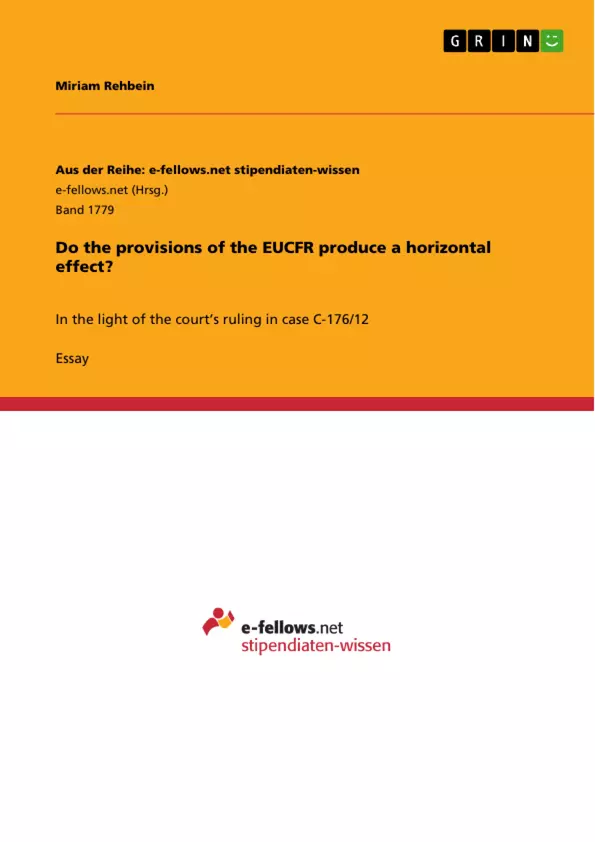This paper deals with one of the most controversial issues of recent years; the horizontal application of EU fundamental rights.
The growing importance of fundamental rights within the European Integration becomes especially noticeable in their increasing textualization. In 1969 the European Court of Justice in Cases showed for the first time sensitivity for Fundamental Rights in the Stauder-Case.
One of the most controversial issues of recent years is the horizontal application of EU fun-damental rights. It is questionable whether fundamental rights can have an impact on private law relationships and more precisely, to what extent they are directly applicable in relations between private individuals. This topic is not just of theoretical interest, but also matters in practice. If there is no European or domestic legislation implementing fundamental rights, individuals may have problems to enforce their rights in private relationships unless those rights are directly applicable.
Table of Contents
- Introduction.
- Incorporated Concept of Horizontal Effect in the Charter?
- The Trio of CJEU cases: Mangold, Kücükdeveci, Dominguez..
- The Association de médiation sociale Case.
- The Ruling of the Court.
- Reactions and Conclusions.......
- Searching for reasons for the Courts attitude
- Conclusion
Objectives and Key Themes
This paper investigates the concept of horizontal effect in European Union law, particularly in the context of the Charter of Fundamental Rights of the European Union (CFR). It aims to determine whether provisions of the CFR can have a direct impact on private law relationships, examining the horizontal application of EU fundamental rights.
- The horizontal effect of the Charter of Fundamental Rights.
- The role of the Court of Justice of the European Union (CJEU) in interpreting and applying the CFR.
- The implications of the CJEU's rulings on the horizontal effect of the Charter.
- The impact of the Charter on private law relationships between individuals.
- The distinction between rights and principles in the Charter and their respective horizontal effects.
Chapter Summaries
- Introduction. This chapter introduces the paper's focus on the horizontal effect of the CFR, highlighting the increasing importance of fundamental rights in European integration and the legal value of the CFR as part of EU primary law. It explores the practical implications of the horizontal effect, particularly regarding the enforcement of individual rights in private relationships.
- Incorporated Concept of Horizontal Effect in the Charter? This chapter examines the Charter itself for indications of horizontal effect, analyzing the wording of Article 51 CFR and its implications for private parties. It further discusses the distinction between rights and principles in the Charter and their respective horizontal effects, referencing the Explanations of the Charter.
- The Trio of CJEU cases: Mangold, Kücükdeveci, Dominguez. This chapter provides an overview of the key CJEU cases that have addressed the potential horizontal direct effect of general principles or Charter provisions, including Mangold, Kücükdeveci, and Dominguez, prior to the recent AMS case.
- The Association de médiation sociale Case. This chapter focuses on the content of the recent C-176/12 Association de médiation sociale (AMS case) and the Opinion of Advocate General Villalón, examining the Court's ruling on the horizontal effect of the CFR.
Keywords
This paper focuses on the horizontal effect of the Charter of Fundamental Rights of the European Union (CFR), the Court of Justice of the European Union (CJEU), EU fundamental rights, private law relationships, direct effect, indirect effect, rights, principles, and the interpretation of the Charter provisions. The paper also explores the impact of the CJEU's rulings on the horizontal effect of the CFR and the implications for individual rights in private relationships.
- Citation du texte
- Miriam Rehbein (Auteur), 2015, Do the provisions of the EUCFR produce a horizontal effect?, Munich, GRIN Verlag, https://www.grin.com/document/313617



